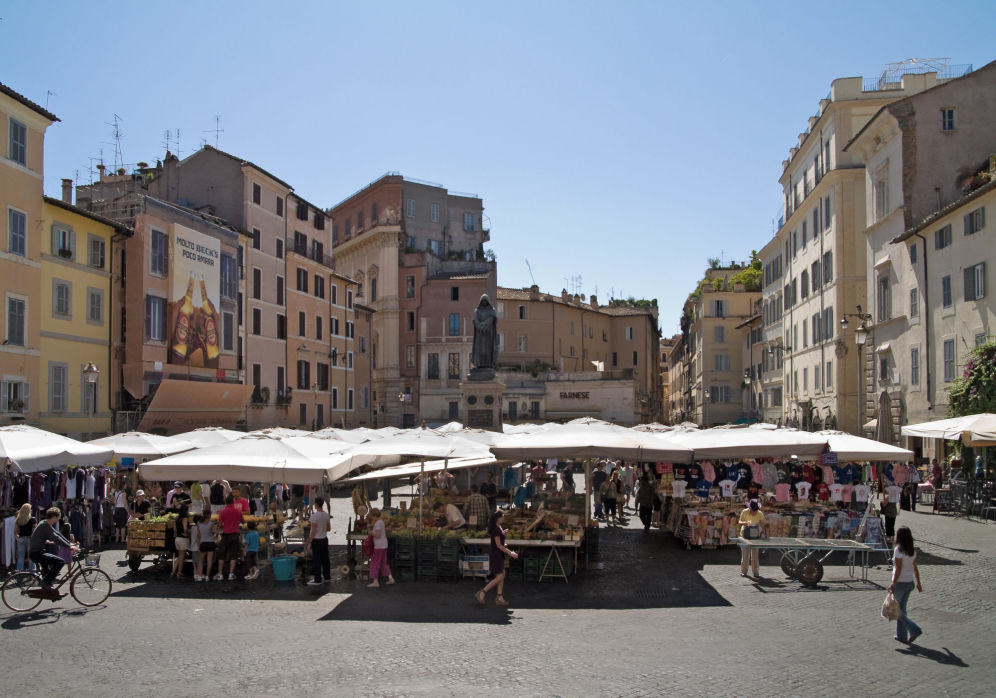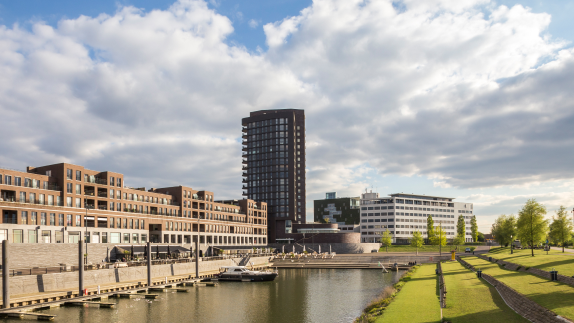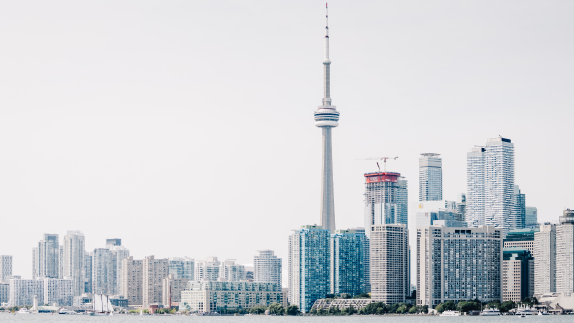
name:
Multiple cities in Italy
origin:
Italy
The food and other bio-resources that supply cities are produced primarily in rural areas. Having entered the city, they are processed and consumed, becoming ‘waste’ in the form of discarded by-products, food waste, and sewage. The volume of discarded material is significant. A 2017 study estimated that each year cities produce 650 million tonnes of organic waste. By 2030, this volume is projected to double.
At a glance
Cities produce huge amounts of organic nutrients, that if managed according to circular economycircular economyA systems solution framework that tackles global challenges like climate change, biodiversity loss, waste, and pollution. It is based on three principles, driven by design: eliminate waste and pollution, circulate products and materials (at their highest value), and regenerate nature. principles can yield many benefits
Key to realising this is effective organic collection systems
A number of regions in Italy have transformed their collection systems with high rates of separation
How was this achieved and what lessons can be applied to other cities around the world
Linear and costly
The food and other bio-resources that supply cities are produced primarily in rural areas. Having entered the city, they are processed and consumed, becoming ‘waste’ in the form of discarded by-products, food waste, and sewage. The volume of discarded material is significant. A 2017 study estimated that each year cities produce 650 million tonnes of organic waste. By 2030, this volume is projected to double.
If these resources are managed effectively, they can be part of a circular economy for food that helps rebuild soil health, recovers valuable resources, and provides feedstock for factories or energy plants. And yet even in ‘advanced’ OECD countries, less than 40% of organics are recycled into valuable uses, so that each year at least 58 million tonnes of potentially recoverable resources are wasted. The result is economic losses, expensive and potentially polluting landfills, and significant greenhouse gas emissions – all hallmarks of a linear take-make-waste system.
Transforming discarded food resources into valuable products requires organic materials to be collected in the first place. Well-managed separation schemes for organics can achieve collection rates of up to 85%. However, in many regions of the world separate organic collection is poor or non-existent, resulting in pollution and lost opportunities. Even in European cities, with developed infrastructure, actual collection rates fall well below what is achievable. How can cities improve organic collection and realise the benefits of a circular economy? A group of Italian cities and regions including Milan, Parma, Sardinia, Treviso, and Capannori may hold the answer to this. Within a few years these positive city examples have significantly improved their systems, and in doing so, have saved money, created jobs, and reduced environmental impacts.
Summary of biowaste separation rates in the focus regions
Before collection comes prevention
Before it is allowed to become ‘waste’, Italian citizens, businesses, and policymakers employ a range of distribution methods to redirect food to people or organisations who need it.
In open-air markets, such as Alberone in Rome and Mercato Albinelli in Modena, as traders start winding down for the day, handwritten signs go up: ‘Raccolta e Distribuzione gratis’ (collection and distribution for free). Similarly, in a variety of supermarkets, such as Co-op and Despar (Aspiag Group), food waste prevention programmes ensure that as food nears the ‘best before’ date it is redistributed to charities.
Technology can play a role in preventing food from ending up in bins. Digital start-up MyFoody allows citizens to find local supermarkets that offer discounts on products nearing their expiration date. People from across the city are also notified of the location of unsold surplus food available for purchase.
National and local policy influences the actions of citizens and urban food system actors by creating signals and incentives. In 2016, the Italian government passed a new set of legislation designed to combat food waste called the Gadda Law. The law aims to encourage businesses to give surplus food away for free through tax breaks, campaigns, and the streamlining of bureaucracy, thus making donating food easier and more flexible. One Gadda initiative entailed a government push for restaurants to provide ‘doggy bags’, so that diners can take their unfinished food home – a habit that is not typically part of Italian culture.
Cities approach the issue of food waste prevention in a variety of different ways. In 2018, the City of Milan adopted a reduction on the tax related to the donation of surplus food. The new regulation works by reducing 20% of the tax for the first year in favour of food businesses (supermarkets, restaurants, canteens, producers etc.) that donate their food surplus to charities. The city has also set up three local Food Waste Hubs in order to achieve the target of 50% food waste reduction by 2030. Each hub – which typically comprises private canteens, supermarkets, street markets, and NGOs – redistributes food to the local neighbourhoods, aiming to avoid 70 tons of waste each year.
Companies and institutions have implemented their own campaigns and projects for prevention and redistribution. Hera’s Cibo Amico collects meals prepared but not eaten from five company canteens and directs this food to local NGOs for redistribution. In 2017 alone nearly 6 tonnes of food waste was prevented through this scheme.

Campo dei Fiori market, Rome (Photo: Creative Commons/Myrabella)
Ingredients for success
A positive mindset
“All the forces in the world are not as powerful as an idea whose time has come.” - Victor Hugo
Changes in mindset are crucial to facilitating actual system changes in society, and initiatives in schools can stimulate this shift. The city of Milan has promoted a number of campaigns in school canteens over the past few years, for example rescheduling snack times to reduce fruit waste, providing reusable ‘doggy bags’, and instituting recovery schemes to donate surplus school dinners. Such initiatives not only prevent food waste, but introduce children to the topic of food waste, thus reinforcing positive habits at an early age.
In Sardinia in 2003, officials were obliged to rethink the food waste system to achieve targets set out in the European landfill directive. At that time, only two out of about 50 municipalities had separate waste collection, and average organic collection rates were less than 4%. To fulfil their legal obligations, Sardinia set up a Regional Programme for Biowaste underpinned by a simple but powerful thought: “while untreated, biowaste is a hazard, but if treated and sorted separately, it could be a benefit for the environment”. The shift in mindset encapsulated by this simple idea is one of the most powerful drivers for transitioning to a less wasteful, more circular system.
In a country such as Italy, this idea has its roots in the nation’s proud heritage in produce and cuisine. As Luigi Riccardo from Intesa Sanpaolo, one of the largest banking groups in Italy, observes, “My grandmother would never consider food scraps as ‘waste’ but would see it as important for feeding the earth to grow the next crop.”
Supporting policy frameworks
With the correct mindset in place, the next stage is to develop policies and incentives (both ‘push and pull’) to create the conditions that allow concrete measures to be adopted.
An example of ‘push’ policy is Sardinia’s biowaste programme, which instituted compulsory separate collection, while at the same time increasing landfill tax for organics to the maximum possible rate. On the ‘pull’ side, a number of regions introduced a system of incentives to reward municipalities with high separate collection rates, and penalise those that lag behind. Municipalities that exceed a threshold rate set slightly above the average receive a rebate, those that fall below pay a surcharge. The whole system is balanced internally, so there are no additional costs. The scheme has so far provided the city of Parma with €710,000 (USD 800,000) in rebates.
Financial instruments exist not only for municipalities, but also for individual households. Pay-as-you-throw (PAYT) tariffs comprise a fixed fee component related to household size and a variable amount based on the volume of residual waste. In some regions, there is an additional incentive connected to the variable tariff, discounting households that practise home compostingcompostingMicrobial breakdown of organic matter in the presence of oxygen. of vegetable waste. This discount can be as much as 30%, in the case of Treviso. The impact of these new tariff systems can be significant, within a few weeks of introducing a PAYT system in the city of Ferrara, collection rates increased from 54% to 85%.
There are also various non-policy interventions that municipalities can enact. For example, being transparent with what happens with the organic flows and where benefits accrue. Communicating how the whole system is improving and emphasising the important contribution of individual households to this story, can galvanise citizens to make a greater effort.
Community as a catalyst for change
In many of the Italian regions analysed, grassroots community mobilisation has been an important driver of change. Many policy interventions and technology installations would not have come about without self-organised community groups lobbying authorities to refocus their priorities.
For example, in Parma a civil society group ensured that the topic of better collection systems was included in all regional election debates. In Capannori, a primary school teacher called Rossano Ercolini started a grassroots movement called Ambiente e Futuro. A central part of their demands was a waste management plan that addressed pollution concerns. A year later Ercollini, now head of the waste management company, started implementing the community-developed collection system, which after a short time facilitated recycling of over 80% of Capannori’s waste.
How cities benefit
The benefits of improving organic collection are potentially far reaching. Direct benefits include an improved urban environment for human health, lower greenhouse gas emissions, and reduced costs for municipalities and households. Indirect benefits can include improved soils in peri-urban areas through cycling of organic fertilisers, more feedstock for the local bioeconomy, and clean renewable energyrenewable energyEnergy derived from resources that are not depleted on timescales relevant to the economy, i.e. not geological timescales. for electricity, district heating, and even transport systems.
For cities, the economic benefits of organic waste collection over disposal are realised in both jobs and cost reduction. In Parma, 44 jobs were created going from roadside to door-to-door collection. At the same time, annual costs have been reduced by €450,000 (USD 510,000), plus the city has received a €710,000 (USD 800,000) financial rebate for achieving the separation targets.
Households have also benefited in Treviso. The average home pays €175 (USD 200) for their annual collection fee, compared to a national average of €250 (USD 290). In the last 15 years, the citizens have experienced only an 8% rise in collection fees compared to 70% nationally.
Lessons learnt
Visualising a city’s organic waste as a flow of beneficial nutrients is a prerequisite to creating a circular economy for food in cities. In doing so, organic waste can be viewed not as a costly hazard, but as something that can benefit the economy, the quality of urban life, and the wider environment. By 2050, cities will consume 80% of food produced, giving them the power to drive a shift to a less polluting, more regenerative system, as well as unlocking USD 700 billion a year through reducing edible food waste and ‘valorising’ organic materials to create new food and products. To realise the many opportunities, better collection systems are needed, that divert edible food to citizens and discarded organics away from landfills, rivers or incinerators, re-routing them instead to factories, energy plants, and farmers’ fields.
In Italy, many cities and regions have succeeded in dramatically transforming their organic collection rates, increasing from 4% to 60% on the island of Sardinia and even reaching 80% in other areas (see table 1). This success relies on a number of factors working together. A strong and engaged civil society, clear national commitments, push and pull policies aligned to positive outcomes, and the application of various technologies.
Applying lessons learnt from Italy to other regions of the world is of course desirable but one must recognise that context varies from place to place.
In the UK, only 40% of municipalities have separate organic collection systems due to reduced council budgets as well as more fundamental constraints, such as the physical layout of streets and buildings. Part of the success of Milan’s collection system is due to the fact that many of its buildings have courtyards for storage, as well as concierge services so that bins can be put out just before collection and thereby minimise disruption. For cities that do not have these features and services, different approaches need to be considered. Therein lies an opportunity for city planners in emerging economies, who will be overseeing the huge projected city expansions in the next decades, to incorporate enabling infrastructure at the design stage of new buildings and infrastructure. Such forward-thinking would ensure that these cities can leapfrog awkward retrofitting later on.
Sardinia

Sardinia: from 4 to 60% in just over a decade (Photo: Roman Kraft/Unsplash)
Guidelines for other cities and regions
1. Make every effort to prevent food becoming waste in the first place.
2. Instil the right mindset: Badly managed biowaste is a hazard. If treated and sorted separately, it can benefit the economy and the environment.
3. Set achievable (phased) targets.
4. Formulate policy / set taxes / incentive schemes that discourage bad practices (e.g. landfilling organics) and encourage good ones (e.g. composting).
5. Consider investing in technology, from simple compostable bags; to commercial composting machines for school canteens
6. For new builds consider building layout and infrastructure to maximise opportunities.
7. Communicate the system story and emphasise the important contribution of citizens.




